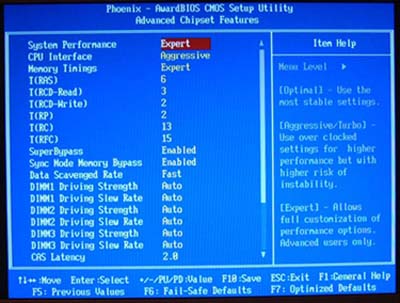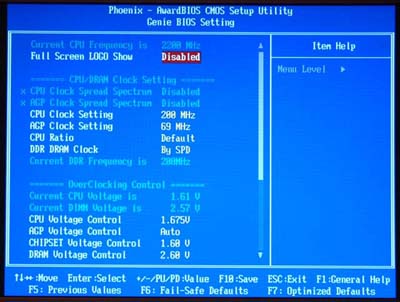DFI NFII Ultra: Mean Green Dream Machine
by Wesley Fink on July 30, 2003 6:25 PM EST- Posted in
- Motherboards
DFI NFII Ultra: BIOS and Overclocking
DFI uses the familiar Award BIOS on the NFII Ultra. Our test board was equipped originally with the 6/05/2003 Performance BIOS. While we were impressed with the incredible array of options available in this BIOS, we had some problems with the stability of the BIOS in some extreme overclocking situations. The later 6/25/2003 BIOS proved to be fast and very stable, and thus, benchmarks were run using this BIOS.DFI later supplied an updated 7/10/2003 Performance BIOS, which proved to combine the excellent stability of the 6/25/2003 BIOS with the incredible selection of tweaking options available in the 6/05/2003 BIOS.

The Performance BIOS has the most incredible array of overclocking options that we have ever seen on an nForce2 board.
FSB - 100-300 in 1MHz intervals
AGP - Auto or FIXED at 1Mhz intervals from 50-100
CPU Ratio - 5X-22X
vCore - Auto, 1.10-2.05 in 0.025v increments
vAGP - Auto, 1.5-1.8 in 0.1v increments
Chipset Voltage - Auto, 1.6-1.9 in 0.1v increments
vDIMM - Auto, 2.5-2.8 in 0.1v increments
RAM Ratios - Auto, 2:1. 5:3, 3:2, 4:3, 5:4, 6:5, 1:1, 5:6, 4:5, 3:4, 2:3, 3:5, 1:2
T(RAS) - 1-15
T(RCD-Read) - 1-7
T(RCD-Write) - 1-7
T(RP) - 1-7
T(RC) - 9-31
T(RFC) - 9-31
Super Bypass - Enable, Disable
Sync Mode Memory Bypass - Auto, Enable, Disable
Data Scavaged Rate - Fast, Normal
DIMM 1 Driving Strength - Auto, 1-15
DIMM 1 Skew Rate - Auto, 1-15
DIMM 2 Driving Strength - Auto, 1-15
DIMM 2 Skew Rate - Auto, 1-15
DIMM 3 Driving Strength - Auto, 1-15
DIMM 3 Skew Rate - Auto, 1-15
CAS Latency - 2.0, 2.5, 3.0
The options available in the Performance BIOS are certainly a demonstration that DFI does know what is involve in producing a board squarely aimed at the computer enthusiast. How can you not be impressed with an enthusiast's dream collection of tweaking options in the Performance BIOS available for this board?

The voltage adjustments, FSB adjustments, and ratio controls are in a menu item DFI calls “Genie”.
We can tell you the added options do make a difference in squeezing every bit of performance from the NFII Ultra, but we have only scratched the surface in mastering the available tweaks. The speed and overclocking abilities with this BIOS are impressive. A word of caution here also: you can get yourself into trouble with the available options if you're not careful. If you don't understand these options, choose AUTO; otherwise, you may be reformatting your hard drive. The 6/25/2003 release version of the BIOS includes a full array of options, but does not include all these options; rather settling for optimum values for most situations. But AMD tweakers will love this Performance BIOS.
The NFII Ultra PC Health section includes System and CPU temperatures, CPU and Chassis fan speeds, Vcore, and Power Supply readings for all rails. There is also an adjustable setting for Maximum CPU temperature that will automatically shut down the system, if the preset temperature is exceeded. DFI includes the familiar Winbond Hardware Monitor for keeping tabs of voltages, temperatures and fan speeds in Windows.
Voltage adjustment options for the DFI NFII Ultra are very well-balanced. We were pleasantly surprised to see vCore adjustments to 2.05V – much higher than offered by most other nForce boards, except those from Epox. The vDIMM adjustment range, while much better than the DFI 975PRO LanParty, tops out at 2.8V. Although this should be adequate for most users, we are now seeing new high-speed memory from OCZ and GEIL that offers warranty support for use at voltages up to about 3.0V. We would have preferred to see the vDIMM reach to the 3.0V to 3.2V range, but in reality, we will not be running nForceII boards at DDR500 as we might on an Intel 875P board. Considering the practical overclocking limits of the nForce 2 Ultra 400, we would conclude that the 2.8V maximum voltage for memory is probably a good choice. Besides, we have chipset voltage adjustments on the NFII Ultra – all the way to 1.9V. In testing overclocks on the NFII Ultra, we found that we often attained better results getting beyond walls by increasing the chipset voltage a bit, rather than increasing vDIMM. Certainly, the wide chipset adjustment range coupled with the decent vDIMM adjustment range gives the overclocker many very effective options.
FSB Overclocking Results
For FSB overclocking, the following setup was used on the NFII Ultra:| Front Side Bus Overclocking Testbed | ||
| Default Voltage | Maximum Overclock | |
| Processor: | Athlon XP 2500+ (Barton Core) | Athlon XP 2500+ (Barton Core) |
| CPU Vcore: | 1.65V (default) | 1.775V (default) |
| Cooling: | Thermalright SK-7 with 80mm Thermaltake Fan | Thermalright SK-7 with 80mm Thermaltake Fan |
| Power Supply: | Powmax 350W | Powmax 350W |
The above overclocking setup at default voltage allowed us to reach a stable FSB of 223MHz. This makes the DFI NFII Ultra the best overclocking nForce2 Ultra 400 board that we have tested at AnandTech. With this kind of performance at default voltage, we were curious just how far we could push the Barton 2500+ with a bit more voltage. We were able to achieve complete stability at 227MHz using 1.775V. This represents a true CPU speed of 2.502GHz from a chip designed to run at 1.83GHz – a 37% overclock. Since the 3200+ runs at 2.2GHz, this would represent a performance rating in the range of 3600+, if such a rating existed.
The DFI NFII Ultra has a very wide range of multiplier adjustments, available from 5.5X all the way up to 22X. The whole range of multipliers appeared to work well on our Barton 2500+. We did not see any missing ranges in the multiplier settings, as have been reported on other nForce2 boards.










46 Comments
View All Comments
Jeff7181 - Thursday, July 31, 2003 - link
... and another thing.What the hell is with showing ONE benchmark results for the Gun Metal DX9 tests? What a complete waste of time those were!
Jeff7181 - Thursday, July 31, 2003 - link
I'm not impressed by this article. Comparing 4 motherboards huh? Don't strain yourselves over there guys.How bout throwing in a couple of the most popular motherboards for AMD rigs? Like the Asus A7N8X Deluxe and Epox 8RDA+
Seems like that would be the smart thing to do since people would be able to relate the performance a lot easier.
Anonymous User - Wednesday, July 30, 2003 - link
You are F-ing kidding me right>?!"Many benchmarks show widely different results with different video hardware, so we have indicated benchmarks run with the ATI Radeon 9800 PRO with an asterisk. Benchmarks without an asterisk were run with the nVidia Ti4600."
So you didn't use the same video card to compare both the NF2 Ultra boards? That is just bad form. Gee I wonder if the motherboard with the 9800 will be a little faster? DUh.
Wesley Fink - Wednesday, July 30, 2003 - link
We described the Raid 1.5 feature in this review, because many readers of our earlier DFI 875PRO review have asked questions about how this feature is supposed to work. We did not test the performance of Raid 1.5, so we did not comment on how it actually performs compared to other RAID configurations.Anonymous User - Wednesday, July 30, 2003 - link
Are you sure about RAID 1.5 too? I've seen several reports that it's nothing more than RAID 1(mirroring) with data being simultaniously read off both drives, which is in turn something a good RAID 1 controller should do anyhow, making RAID 1.5 marketing fluff.Wesley Fink - Wednesday, July 30, 2003 - link
Corrections are in process right now. When a review is written it is spell-checked, emailed, and then actually posted by a Managing Editor who is located thousands of miles from my location. The graphs are also created from formatted raw data at that point. Since I am new to Anandtech, then these kinds of errors do happen, and we take them very seriously.I sincerely apologize, but the errors will be corrected very soon. Since I am learning the Anandtech procedures, the fault is mine.